Sewage – the problem
The discharge of raw sewage into the sea can create a health hazard. Sewage can also lead to oxygen depletion and can be an obvious visual pollution in coastal areas - a major problem for countries with tourist industries.
The main sources of human-produced sewage are land-based - such as municipal sewers or treatment plants. However, the discharge of sewage into the sea from ships also contributes to marine pollution.
Annex IV of MARPOL
Annex IV contains a set of regulations regarding the discharge of sewage into the sea from ships, including regulations regarding the ships' equipment and systems for the control of sewage discharge, the provision of port reception facilities for sewage, and requirements for survey and certification.
The Annex entered into force on 27 September 2003. A revised Annex IV was adopted on 1 April 2004 and entered into force on 1 August 2005.
The revised Annex applies to ships, engaged in international voyages, of 400 gross tonnage and above or which are certified to carry more than 15 persons. The Annex requires ships to be equipped with either an approved sewage treatment plant or an approved sewage comminuting and disinfecting system or a sewage holding tank.
Definitions
Sewage means:
- drainage and other wastes from any form of toilets and urinals;
- drainage from medical premises (dispensary, sick bay, etc.) via wash basins, wash tubs and scuppers located in such premises;
- drainage from spaces containing living animals; or
- other waste waters when mixed with the drainages defined above.
Untreated Sewage means sewage that has not been treated by a type approved sewage treatment plant, or that has not been comminuted and disinfected.
Grey water – is drainage from dishwater, galley sink, shower, laundry, bath and washbasin drains and does not include drainage from toilets, urinals, hospitals, and animal spaces, as defined in regulation 1.3 of MARPOL Annex IV and does not include drainage from cargo spaces.
Regulating grey water is a necessity
Regulating grey water together with black water makes the existing performance standard more attainable and practicable. Because grey water is often co-mingled with black water during storage and transfer on board, regulating grey water is essential for effective implementation of the proposed sewage record books.
There are other reasons too. For years, grey water related non-conformities have been persistent. Sending grey water to an STP’s final stage is a non-conformity wrongly approved and promoted by the classification societies since 2016. Ship’s grey water system is also becoming a dumping ground for regulated wastes, such as food waste and food waste derivatives, violating international marine rules and national biosecurity rules. The interferences of grey water to the Ballast Water Convention also remain outstanding. Regulating grey water can help to address these issues.
Regulating grey water can ultimately align the maritime industry to the rest of our society in protecting our coastal waters with integrated and consistent regulations, both on land and at sea.
Holding tank - means a tank used for the collection and storage of sewage.
Nearest land - The term ``from the nearest land'' means from the baseline from which the territorial sea of the territory in question is established in accordance with international law except that, for the purposes of the present Convention.
Regulation 8 Discharge of sewage
Subject to the provisions of regulation 9 of this Annex, the discharge of sewage into the sea is prohibited, except when:
(a) the ship is discharging comminuted and disinfected sewage using a system approved by the Administration in accordance with regulation 3(1)(a) at a distance of more than 4 nautical miles from the nearest land, or sewage which is not comminuted or disinfected at a distance of more than 12 nautical miles from the nearest land, provided that in any case, the sewage that has been stored in holding tanks shall not be discharged instantaneously but at a moderate rate when the ship is en route and proceeding at not less than 4 knots; the rate of discharge shall be approved by the Administration based upon standards developed by the Organization; or
(b) the ship has in operation an approved sewage treatment plant which has been certified by the Administration to meet the operational requirements referred to in regulation 3(1)(a)(i) of this Annex, and
- (i) the test results of the plant are laid down in the ship's International Sewage Pollution Prevention Certificate (1973);
- (ii) additionally, the effluent shall not produce visible floating solids in, nor cause discoloration of, the surrounding water; or
(c) the ship is situated in the waters under the jurisdiction of a State and is discharging sewage in accordance with such less stringent requirements as may be imposed by such State.
Standard as per MEPC.159(55)
Thermotolerant Coliform Standard
The geometric mean of the thermotolerant coliform count of the samples of effluent taken during the test period should not exceed 100 thermotolerant coliforms/100 ml as determined by membrane filter, multiple tube fermentation or an equivalent analytical procedure.
Total Suspended Solids (TSS) Standard
The geometric mean of the total suspended solids content of the samples of effluent taken during the test period shall not exceed 35 mg/l.
Type approval Certificate
Regulation 9 Exceptions
Regulation 8 of this Annex shall not apply to:
- the discharge of sewage from a ship necessary for the purpose of securing the safety of a ship and those on board or saving life at sea; or
- the discharge of sewage resulting from damage to a ship or its equipment if all reasonable precautions have been taken before and after the occurrence of the damage, for the purpose of preventing or minimizing the discharge.
Regulation 11 Standard discharge connection
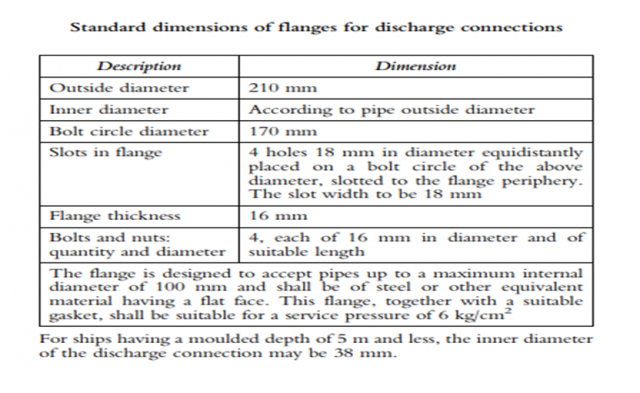
Special Areas under MARPOL Annex IV
Baltic Sea
Date of Entry into Force – 01.01.2013
RESOLUTION MEPC.200(62)
Adopted on 15 July 2011 AMENDMENTS TO THE ANNEX OF THE PROTOCOL OF 1978 RELATING TO THE INTERNATIONAL CONVENTION FOR THE PREVENTION OF POLLUTION FROM SHIPS, 1973 (Special Area Provisions and the Designation of the Baltic Sea as a Special Area under MARPOL Annex IV)
The most recent amendment for MAPOL annex IV was enforced on January 2013, wherein, the Baltic sea area has been adopted as the first special area for sewage discharge regulation. This regulation targets passenger ships, which are the major cause of sewage-related pollution at sea and in coastal water bodies.
This regulation bans the discharge of untreated sewage out at sea in the Baltic area region. The untreated “raw” sewage produced on the ship can either be treated in an STP before discharge or the collected sewage can be transferred to the shore facility.
The sewage treatment plant installed on a passenger ship, intending to discharge sewage effluent in Special Areas, should additionally meet the nitrogen and phosphorus removal standards when tested for its Certificate of Type Approval by the Administration.
Shortcomings in Sewage Regulation
– MARPOL Annex IV does not address those vessels carrying fewer persons, which can be ships and ferries plying in domestic waters. However, there are several smaller vessels around which are discharging wastewaters that are not subject to these legal regulations
– Tourism/recreational vessels such as yachts and small boats are also not covered under the MARPOL regulation. In fact, such vessels contribute to a good percentage of marine pollution, especially in countries with a high number of tourists
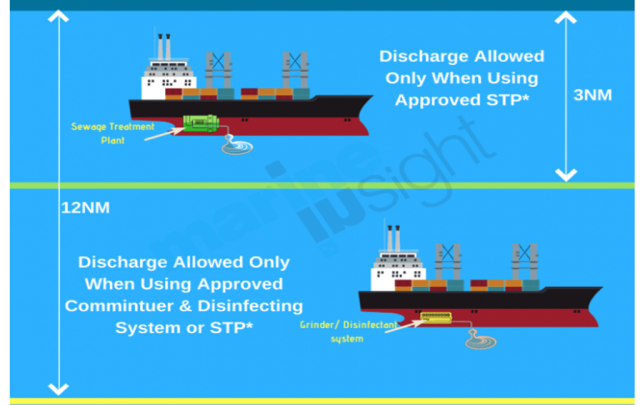
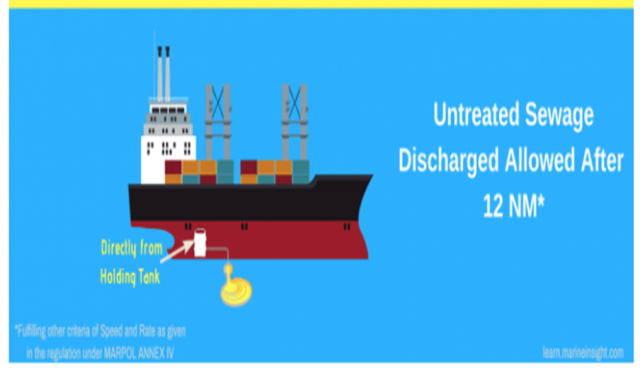
PLEASE NOTE IN VENICE LAGOON IS FORBIDDEN TO DISCHARGE SEWAGE WATERS EVEN IF TREATED.
- Above information were received from Agent in pre-arrival check list.
PLEASE NOTE IN INNER WATER OF BELGIUM IS FORBIDDEN TO DISCHARGE SEWAGE WATERS EVEN IF TREATED.
- Above information were received from MARPOL Inspector in Antwerp.
PLEASE NOTE IN INNER WATER OF ISRAIL (inside of 4 miles zone from shore) IS FORBIDDEN TO DISCHARGE SEWAGE WATERS EVEN IF TREATED.
- Above information were received from following letters
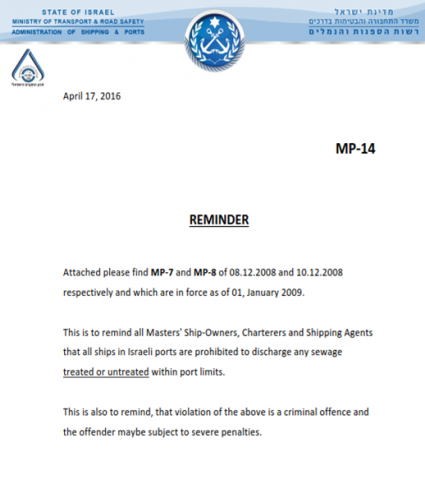
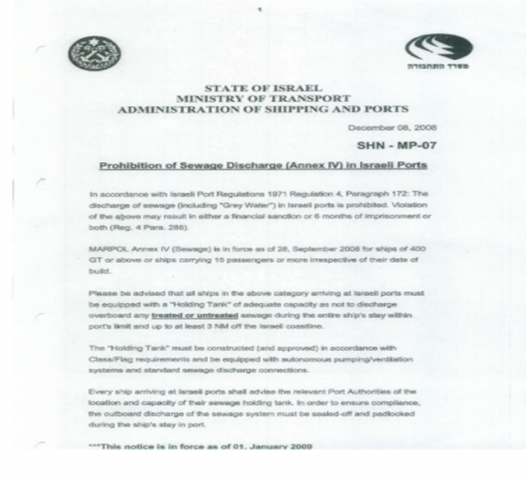
Sewage Water Regulation in Black Sea
- Discharging of treated and untreated sewage water is prohibited in territorial water of Ukraine, Romania, Bulgaria, Russia
- Base on local regulations
Shanghai Area - below information from our Main Agency in China
- Dear sir,
- Please be advised that vessels de-ballasting/sewage water was prohibited from 1st/Oct,2016 as per Shanghai environment protection stipulation(2016) issued by local municipal government, unfortunately, English version is not available.
Many thanks with best regards!- Wangjian
- Penavico Shanghai Pudong Co.,Ltd
- BBC Team (Support)
- 5/F Wang Jiao Plaza, 175 Yan An Dong Road
- Huang Pu District, Shang Hai, China, 200002
- Phone: +86 21 61282533
- Fax: +86 21 61282599
- Mobile: +86 13817306873
- Email : bbc@penavicopd.com
Inner water of Germany
- Police of Hamburg
- Waterways Police
- WSP 02
- Staff department/Principle matters
- by the “See-Umweltverhaltensverordnung” [“Marine Environment Behaviour Ordinance”]), it is allowed to discharge Sewage while moving within the German territorial and coastal waters, inner waterways as per MARPOL-Annex IV regulation 11 (= treated wastewater from well-operated and certified Sewage Treatment Plants). Exception: ship is moving directly from one German port to another German port inside coastal waters.
- In addition, it could be possible that you need a special permit (“Wasserrechtliche Erlaubnis”) for the discharge into the Port of Hamburg according to the "Hamburg Water Act".
- The competent authority for Hamburg is:
- Behörde für Stadtentwicklung und Umwelt (BSU)
- Amt für Immissionsschutz und Betriebe (IB)
- Anlassbezogener Gewässerschutz, Direkteinleiter
- Neuenfelder Straße 19
- 21109 Hamburg
- 040/42840-3732
- Frau Bussink-Becking
- bussinkbecking@bsu.hamburg.de
- With respect to the "Port Health Ordinance" the discharge of untreated sewage is strictly prohibited.
- For the “Kiel-Canal” and the river Elbe the GDWS might be competent authority for a special permit (“Wasserrechtliche Erlaubnis”):
- Generaldirektion Wasserstraßen und Schifffahrt, Außenstelle Nord
Kiellinie 247
24106 Kiel - Telefon: 0431/3394-0; gdws@wsv.bund.de
Turkey
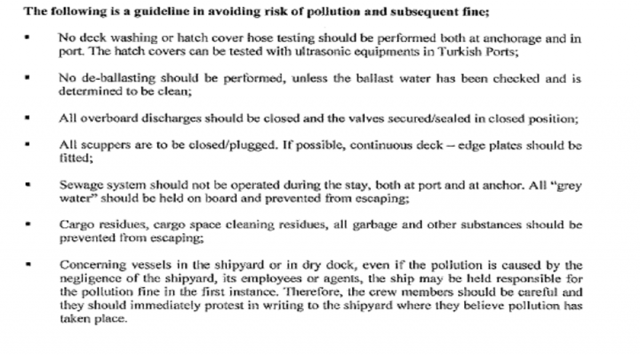
Australia
- Bunbury Port applies Regulation 17 of the Western Australia Port Authority Regulations. This states;
- ‘Unless authorised by a member of staff of the port authority, the master of a vessel must not cause or permit any waste water or waste substances of any kind to be discharged from the vessel on to any part of a wharf or into the waters of the port.’
- AMSA’s Marine Notice 17/2008 refers to the ‘Annex IV - Commencement of Regulations for Existing Ships. Under the terms of MARPOL, existing ships were given until 27 September 2008 to comply with new requirements regarding prevention of pollution by sewage from ships. This refers to ships of 400GT and above. Ships are required to be equipped with one of the following sewage systems;
- A sewage treatment plant that is type approved by an Administration against the standards and test methods developed by the IMO;
- A sewage comminuting and disinfecting system approved by the Administration, fitted with facilities for the temporary storage of sewage when the ship is less than 3 nautical miles from the nearest land; or
- A holding tank.
- Untreated sewage may only be discharged at a distance of more that 12 nautical miles from the nearest land.
- Comminute and disinfected sewage may only be discharged at a distance of more than 3 nautical miles from the land.
- Treated sewage discharged from an IMO approved sewage system may be discharged at any location providing the effluent does not produce visible floating solids or cause discolouring of the water.
- If a vessel wishes to discharge effluent from an IMO approved certified sewage treatment unit within the Bunbury Port Limits, the vessel must demonstrate that it has an IMO certified sewage treatment unit on board and that this has been approved by the vessel’s Administration.
- All agents who receive a request from a vessel to discharge effluent as above must request confirmation of the vessel’s International Sewage Pollution Prevention Certificate (ISPPC) details including expiry date, and also the vessel must demonstrate that the equipment onboard has been approved by an Administration. If these provisions can not be demonstrated, the vessel will not be allowed to discharge effluent of any kind and must retain all sewage water onboard until the vessel has departed the port. Alternatively, sewage retained onboard in a holding tank can be collected by an approved and licensed waste contractor whilst the vessel is in port.
- An Administration is normally a flag state or Classification Society.
China
- Circular Ref No.:PNI1811
- In inland waters and sea water areas within 3 nautical miles away from the nearest land, according to the type of ships and the time of installation/replacement of sewage treatment equipment, the corresponding pollutant discharge limits of sewage after treated by onboard sewage treatment device are shown as below
- Ships that have installed/replaced sewage treatment devices before 01.01.2012, the discharging limits of sewage should be in line with below table
|
No |
Pollutants |
Limits |
Monitoring location |
|
1 |
BOD5 (mg/L) |
50 |
Water outlet of sewage treatment facility |
|
2 |
Suspended matter (SS)(mg/L) |
150 |
|
|
3 |
Heat resistant coliform group (Piece/L) |
2500 |
- Ships that installed/replaced sewage treatment devices after 01.01.2012, the discharging limits of sewage should be in line with below table(except the passenger ships)
|
No |
Pollutants Items |
Limits |
Monitoring location |
|
1 |
BOD5 (mg/L) |
25 |
Water outlet of sewage treatment facility |
|
2 |
Suspended matter (SS)(mg/L) |
35 |
|
|
3 |
Heat resistant coliform group (Piece/L) |
1000 |
|
|
4 |
CODcr (mg/L) |
125 |
|
|
5 |
PH (Dimensionless) |
6-8.5 |
|
|
6 |
Total chlorine (mg/L) |
<0.5 |
All ports of United Arab Emirates
- Discharging of sewage either treated or un-treated is Not Allowed In Dubai Ports
- Base on information from Environment, Health and Safety Department of Pot Dubai
What to do?
- If vessel has Sewage Holding tank then discharging from Sewage Plant to be shifted to tank before entering above areas with record about into Engine Log Book
- If the vessel has not Sewage Holding tank please contact your Inspection Group for the instructions